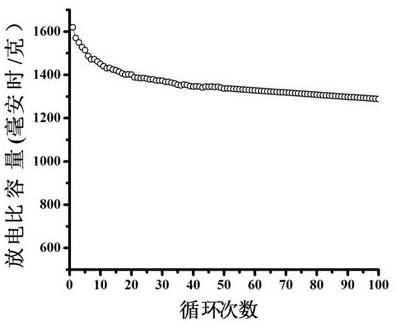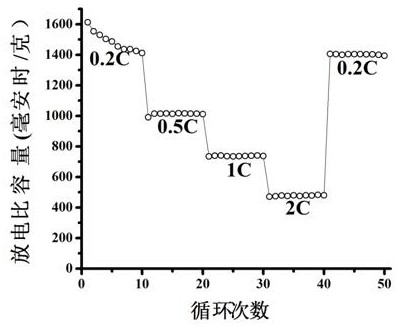Preparation method and application of a sulfur-polypyrrole-two-dimensional layered titanium carbide composite material
A two-dimensional layered and composite material technology, applied in the field of material chemistry, can solve the problems of specific capacitance and capacitance to be improved, and achieve the effect of improving capacitance, good conductivity, and large energy storage space
- Summary
- Abstract
- Description
- Claims
- Application Information
AI Technical Summary
Problems solved by technology
Method used
Image
Examples
Embodiment 1
[0024] (1) Preparation of two-dimensional layered Ti 2 C:
[0025] 0.8g Ti 2 AlC powder was placed in 80mL of hydrofluoric acid solution (mass fraction: 40%), heated to 60°C, and reacted for 18 hours under magnetic stirring conditions. After the reaction was completed, the product was collected by centrifugation, washed repeatedly with deionized water until the pH was neutral, and dried in an oven at 60°C for 12 hours to obtain a two-dimensional layered Ti 2 c.
[0026] (2) Preparation of polypyrrole-Ti 2 C composite material:
[0027] Take the two-dimensional layered Ti prepared in step (1) 2 C 0.8g, 0.5g anhydrous sodium acetate, 1.5mL pyrrole monomer was dissolved in 30 mL deionized water, dispersed evenly by ultrasonication for 20 min, and placed in a refrigerator at 4°C for 2 hours. After that, 8 mL of ferric chloride solution (concentration: 0.03 mol / L) was added, and then placed in the refrigerator at 4°C for 2 hours. After the reaction was completed, the product...
Embodiment 2
[0033] (1) Preparation of two-dimensional layered Ti 2 C:
[0034] 0.5g Ti 2AlC powder was placed in 50mL hydrofluoric acid solution (mass fraction: 20%), heated to 50°C, and reacted for 12 hours under magnetic stirring conditions. After the reaction was completed, the product was collected by centrifugation, washed repeatedly with deionized water until the pH was neutral, and dried in an oven at 60°C for 12 hours to obtain a two-dimensional layered Ti 2 c.
[0035] (2) Preparation of polypyrrole-Ti 2 C composite material:
[0036] Take the two-dimensional layered Ti prepared in step (1) 2 C 0.5g, 0.3g anhydrous sodium acetate, 1mL pyrrole monomer dissolved in 20mL deionized water, ultrasonically dispersed for 10 min, and placed in a refrigerator at 2°C for 1 hour. Then take it out and add 5mL of ferric chloride solution (concentration: 0.01 mol / L), and then put it in the refrigerator at 2°C for 1 hour. After the reaction was completed, the product was collected by cent...
Embodiment 3
[0040] (1) Preparation of two-dimensional layered Ti 2 C:
[0041] 1g Ti 2 AlC powder was placed in 100mL of hydrofluoric acid solution (50% by mass), heated to 80°C, and reacted for 24 hours under magnetic stirring conditions. After the reaction was completed, the product was collected by centrifugation, washed repeatedly with deionized water until the pH was neutral, and dried in an oven at 60°C for 12 hours to obtain a two-dimensional layered Ti 2 c.
[0042] (2) Preparation of polypyrrole-Ti 2 C composite material:
[0043] Take the two-dimensional layered Ti prepared in step (1) 2 C 1g, 0.6g anhydrous sodium acetate, 2mL pyrrole monomer was dissolved in 50mL deionized water, ultrasonically dispersed for 30 min, and placed in a refrigerator at 10°C for 3 hours. Then take it out and add 10mL of ferric chloride solution (concentration: 0.05 mol / L), and then put it in the refrigerator at 10°C for 3 hours. After the reaction was completed, the product was collected by c...
PUM
| Property | Measurement | Unit |
|---|---|---|
| electrical conductivity | aaaaa | aaaaa |
Abstract
Description
Claims
Application Information
 Login to View More
Login to View More - R&D
- Intellectual Property
- Life Sciences
- Materials
- Tech Scout
- Unparalleled Data Quality
- Higher Quality Content
- 60% Fewer Hallucinations
Browse by: Latest US Patents, China's latest patents, Technical Efficacy Thesaurus, Application Domain, Technology Topic, Popular Technical Reports.
© 2025 PatSnap. All rights reserved.Legal|Privacy policy|Modern Slavery Act Transparency Statement|Sitemap|About US| Contact US: help@patsnap.com


